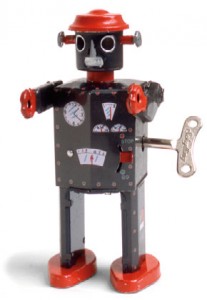
When I was trying to figure out my Class IV Talk, one of my friends asked me what I like to do. After a fairly boring list, I announced that I like to make things, and break things. While I can assure you that breaking things can be a lot less frustrating and more fun than making things, people usually think of it as destructive, although I can’t imagine why. For that reason, my Talk is about making things—some interesting things that I’ve made, some famous inventors who have actually made important things, and what we can learn from them.
What do I mean by “things”? All sorts of things. My inclination to make things goes back a long time. The first really interesting thing I built came to life on a snow day when I was 12. After a long time researching, all the parts lay on my bedroom floor waiting. Once the snow day call came, I began. After about seven hours, I plugged it in and pressed the power switch. A loud whirring sound started and text came flying across the screen; I had built my first computer.
After building this one, which now resides in my room, and a few others for my friends, I started to get bored. You see, computers are all pretty much the same. Faster or slower, bigger or smaller, they all do the same things with the same basic parts. So I became interested in electronics I could design from the ground up. One of my favorite projects was a robot I worked on last summer. It was small, and couldn’t drive in a very straight line, but I built it from the simplest components possible, and I was proud of it. After a few days’ work, I had a robot that would drive around by itself and would detect and avoid nearby obstacles. Driving aimlessly around my house, making loud noises and sometimes falling apart, it was clueless to the tragic fate that awaited it. My little robot wasn’t very smart, and one day, feeling adventurous, it took on the stairs. The stairs won. The robot was lying in pieces on the floor, every single wire and part strewn about. I wish I could say that I went right back to work, rebuilding. Instead, I put the parts in a box, put it on a shelf, and went to watch TV. Eventually, I did put it back together, but it broke several more times. This is the way many of my projects go. Mistakes like these can be really frustrating, but they aren’t the end of the world.
My current project is a robot that makes sandwiches. If I ever convince it to stop throwing cheese slices and start placing them on the bread, that will be exciting, but not earth-shattering. This provides perspective about real inventors trying to build something useful or important, like the lightbulb. How much more frustrating is that, and how much more effort and determination is required, to invent a rocket ship or a lightbulb, than to create a sandwich-making robot?
 We can learn a lot from famous inventors. Thomas Edison spent years working on an idea that seemed impossible: the electric lightbulb. When asked why he failed so many times before stumbling upon the right combination of the carbonized fi lament, he replied, “I didn’t fail. I found 2,000 ways how not to make a lightbulb.” This kind of dedication makes invention possible. And Edison was dedicated. According to an article on Wired.com, Edison electrocuted a condemned elephant to death in front of 1,500 people to prove a point about the dangers of alternating current. Edison epitomized perseverance. According to Rutgers.edu and the United States Patent and Trademark Office, Edison was awarded 1,093 patents, the third most in history. He applied for an additional 600 patents, which were rejected, but he didn’t allow that to slow him down. Edison’s inventions spanned mining to telephones and electricity to sound, and his impact was profound on all of these fields.
We can learn a lot from famous inventors. Thomas Edison spent years working on an idea that seemed impossible: the electric lightbulb. When asked why he failed so many times before stumbling upon the right combination of the carbonized fi lament, he replied, “I didn’t fail. I found 2,000 ways how not to make a lightbulb.” This kind of dedication makes invention possible. And Edison was dedicated. According to an article on Wired.com, Edison electrocuted a condemned elephant to death in front of 1,500 people to prove a point about the dangers of alternating current. Edison epitomized perseverance. According to Rutgers.edu and the United States Patent and Trademark Office, Edison was awarded 1,093 patents, the third most in history. He applied for an additional 600 patents, which were rejected, but he didn’t allow that to slow him down. Edison’s inventions spanned mining to telephones and electricity to sound, and his impact was profound on all of these fields.
Steve Wozniak is a less well known but also significant inventor. You all are certainly familiar with his work: Wozniak helped to invent the personal computer as we know it and then co-founded Apple Inc. An article on Woz.org states that President Ronald Reagan gave Wozniak the National Medal of Technology in 1985, the highest award for American inventors. Equally important was what Wozniak did with his invention. He believes that everyone deserves equal access to technology, and he sponsored efforts to put computers and Internet access into everyone’s hands so that the world would benefit from what he helped to invent. Edison’s perseverance and Wozniak’s ideals are examples of how inventors benefit the entire world and provide goals to live by, both for inventors and non-inventors.
In no way am I comparing myself to these incredible inventors. Even I’m not that crazy. I just think it’s really interesting that whether you’re building a robot that likes to drive off of staircases or inventing the lightbulb, you go through the same process of innovation. Without that innovation we would still be sitting in caves hitting sticks together. Without iPods. What a horrible fate.
Nate Bresnick ’14
Class IV—The Best of the Talks



